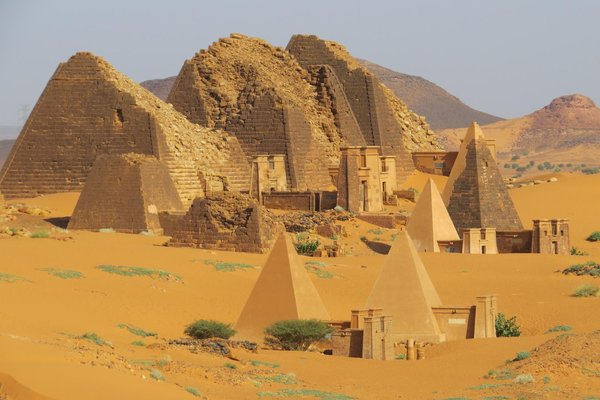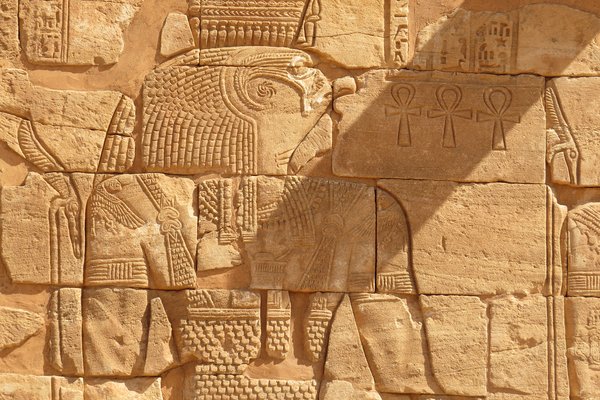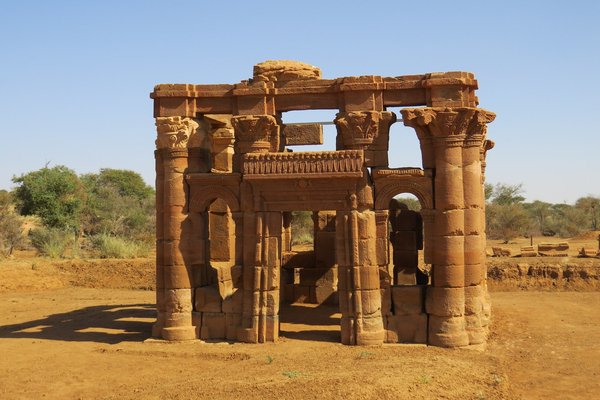Sudan
Meroe
The Archaeological Sites of the Island of Meroe contain the best-preserved relics of the Kingdom of Kush at the height of its power.
Meroe became their capital in the 3rd century BCE, with its proximity to the Nile making it a viable location for human existence. The three components include the town of Meroe and its cemetery, and the associated sites Musawwarat es-Sufra and Naqa which are located in the desert further from the river. As the site of royal burials, most notable are the more than 200 Kushite pyramids that have survived.
Community Perspective: It doesn’t lie too far from Khartoum, so it is more often visited than Gebel Barkal. The focal point is the pyramid field of the Meroë Necropolis, but don’t miss Musawwarat (it has a finely restored temple and magnificent carvings) and Naqa (where the Kushites showed that they'd been in contact with Roman / Hellenistic structures).
Site Info
Official Information
- Full Name
- Archaeological Sites of the Island of Meroe (ID: 1336)
- Country
- Sudan
- Status
-
Inscribed 2011
Site history
History of Meroe
- 2011: Revision
- Includes former TWHS Naqa (2003)
- 2011: Advisory Body overruled
- ICOMOS recommended Deferral for reasons of comparative analysis, management etc. Brz, Chi, Egy, Eti, Jor, Irq, Mal, Nig, Uae get acceptance of inscription
- 2011: Inscribed
- Inscribed
- 2010: Incomplete - not examined
- Type
- Cultural
- Criteria
- ii
- iii
- iv
- v
Links
- UNESCO
- whc.unesco.org
- Related
-
- musawwaratgraffiti.mpiwg-berlin.mpg.de — The Musawwarat Graffiti Archive
All Links
UNESCO.org
- whc.unesco.org — whc.unesco.org/
Related Resources
- musawwaratgraffiti.mpiwg-berlin.mpg.de — The Musawwarat Graffiti Archive
News Article
- June 30, 2024 msn.com — Sudan fighting spreads to the sites of Naqa and Musawwarat es-Sufra
- Jan. 19, 2024 whc.unesco.org — UNESCO calls for the protection of the World Heritage Site of the Island of Meroe, after recent reports of military activities
- Sept. 8, 2020 bbc.com — Sudan floods: Nile water level threatens ancient pyramids
- Feb. 22, 2016 heritagedaily.com — Pyramid of Queen Khennuwa investigated for the first time in almost a century
Community Information
- Community Category
- Archaeological site: Classical (other)
Travel Information
Red Zone Travel Advisory
Recent Connections
-
Red Zone Travel Advisory
Sudan fully off-limits -
On Banknotes
Pyramids at one side of the 100 Sudanes… -
On Coins
Meroë Pyramid with entranceSee en.numis…
Connections of Meroe
- Individual People
-
-
Visited by Nicolas Hulot
Émission 23 : Au pays des pharaons noirs (Soudan, 2003) -
Johann Ludwig Burckhardt
Burckhardt noticed the ruins of the town in 1814, but he underestimated their importance (nom file) -
Prince Pückler
Meroe - Arqamani's Pyramid, Musawwarat es Sufa ("PÜCKLER MUSKAU EST VENU VISITER CES RUINES MANDEE PAR SON ESPRI FAMILIER") and NaqaSee de.wikipedia.org
-
- Geography
-
-
Desert Cultural Landscapes
Crit v "The major centres of human activity far from the Nile at Musawwarat and Naqa raise questions as to their viability in what is today an arid zone devoid of permanent human settlement. They offer the possibility, through a detailed study of the palaeoclimate, flora, and fauna, of understanding the interaction of the Kushites with their desert hinterland." -
Sahara
It lies in the savannah belt on the south side of the Sahara (AB) -
Nile
The City as opposed to the more famous Cemetaries with their pyramids is very close to the Nile "Meroe is in two parts: Meroe 1 (town site) west of the highway covers 612.551ha and Meroe 2 (cemetery site) east of the highway covers 674.904ha....... The site of the royal city of Meroe, known today as Begraweya, is near the banks of the river Nile about 220 north of Khartoum....... The bath structure .....was supplied by a brick vaulted, cement-lined aqueduct. Filling the basin depended on the water level of the Nile;it was only operative at the high Nile and was associated with inundation, the New Year and by extension, the cult of the ruler " (AB Eval)
-
- Trivia
-
-
In the Louvre
Offering tableSee www.louvre.fr
-
On Coins
Meroë Pyramid with entranceSee en.numista.com
-
On Banknotes
Pyramids at one side of the 100 Sudanese Pounds note (2019, 2021)See www.banknote.ws
-
In the British museum
The best of the reliefs were taken down stone by stone in 1905, and set up partly in the British Museum (wiki)
-
- History
-
-
Specified on Herodotus' Oikumene
-
Mentioned by Pliny the Elder
Chapter 10, River Nile: "When making the circuit of Meroe ..." (he thought it was an island)
-
- Architecture
-
-
Brick architecture
The latest pyramids were faced in brick (nom file)
-
- Damaged
-
-
Blown up
In 1834 Giuseppe Ferlini blew the tops of many pyramids whilst searching for treasure
-
- World Heritage Process
-
-
First sites filling gaps cited by ICOMOS
Ancient Egypt 2011
-
Derived from more than one TWHS
Meroe, Naqa and Musawwarat es-Sufra all appeared separately on the T List
-
- Human Activity
-
-
Historical Graffiti
Great Enclosure at Musawwarat es-Sufra: visitors have left their mark, including the French adventurer Frederic Cailliaud in 1821 (Sudan Bradt Guide). As well from the Meroitc period and the younger post-Meroitic, Christian and Islamic periods -
Writing systems
Meroe script -
Language isolate
Meroitic (debated if it's isolate or not, sometimes connected to Afro-Asiatic)
-
- Constructions
-
-
Pyramids
several pyramidal funerary monuments -
Cemeteries
The cemeteries are characterised by tall pyramids (AB evaluation) -
Dynastic Burial Places
Contains the tombs of several Kentakes of Kush (as well as numerous Kings)See en.wikipedia.org
-
Baths
Roman baths at Meroe city archaeological site
-
- Timeline
-
-
Built in the 3rd century BC
The property consists of the royal city of the Kushite kings from the 3rd century BCE (AB)
-
- Science and Technology
- Visiting conditions
-
-
Red Zone Travel Advisory
Sudan fully off-limits
-
- Literature & Film
-
-
History of the World in 100 objects
No 35 Head of Augustus 27-25 BCSee www.bbc.co.uk
-
News
- msn.com 06/30/2024
- Sudan fighting spreads to the site…
- whc.unesco.org 01/19/2024
- UNESCO calls for the protection of…
- bbc.com 09/08/2020
- Sudan floods: Nile water level thr…
Recent Visitors
Visitors of Meroe
- Adrian Turtschi
- Ali Zingstra
- A. Mehmet Haksever
- Ammon Watkins
- amychemu
- Artur Anuszewski
- Astraftis
- Bill Maurmann
- Boj
- David Marton
- Elf21
- Els Slots
- Emili Xaus
- Fernweh
- Gernot
- Harry Mitsidis
- Jon Opol
- Kevin247
- Krijn
- Luis Filipe Gaspar
- Maciej Gil
- marcel staron
- Marcobrey
- Michael Novins
- Mikko
- Naim Y
- Philipp Leu
- Rahelka
- Roger Ourset
- Roman Bruehwiler
- Solivagant
- Szucs Tamas
- Timothy C Easton
- Westwards
Community Reviews
Show full reviews
I organized my December 2019 trip to Sudan with ITC Sudan and stayed at their Nubian Rest Camp near the foot of Jebel Barkal and Meroe Camp overlooking the pyramid field. I stayed at Acropole Hotel in Khartoum at the beginning and end of my trip, and in between visited Jebel Barkal, a holy mountain surrounded by the ruins of two thirteenth century BCE temples and some of the most intact pyramids in Sudan, erected between the third and first centuries BCE; Nuri in northern Sudan, where more than twenty ancient pyramids that served as a necropolis for Nubian kings and queens still stand near the Nile; Meroë, an ancient city along the eastern bank of the Nile and home to hundreds of Nubian pyramids; the Temple of Apedemak at Naqa, dating from the first century CE and one of the largest ruined sites in Sudan; and Musawarat es-Sufra, a large temple complex dating back to the third century BCE.
Keep reading 0 comments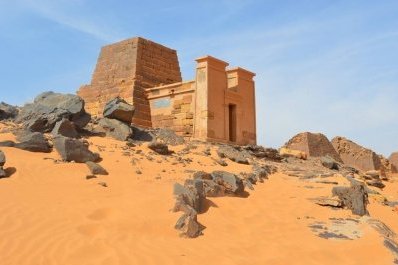
As soon as you enter Sudan, you can see each and every advertisement that have the slightest connection with tourism having the image of the pyramids, and that implies that Meroe is the crown jewel of the Sudanese tourism, and its relative closeness to Khartoum makes it the most touristy place in the whole country. But do not expect crowds of tourist flocking the ruins. When we visited meroe last December seemingly we were the only foreigners there. The presence of desperate souvenir sellers and guys who offered rides on their camels shows that there were better times, and maybe there are days when there are more people coming.
The site consists of two major parts, the capital of the Meroitic kingdom, and its necropolis. The capital is a bit more far away from the main road. it's more or less completely ruined, you need an extremely good imagination to see the lush palaces and pompous temples of Egyptian and local gods in the less than a meter high cramped walls. But the scenery with the trees offering a shadow for the exhausted traveller is impressive and with a knowledgeable guide it can be a somewhat interesting experience.
On the contrary the necropolis in the red desert is touching for the first sight. One of the most impressive sites I've ever seen. The pyramids are much smaller than their Egyptian brothers and much younger too, but not less interesting or mysterious. The black stone buildings in the reddish …
Keep reading 0 comments
After I had visited the excellent Gebel Barkal, I wondered if Meroë could surpass it. Well, it did. I do not hesitate to compare this collection of 4 archaelogical sites in the heart of Sudan with Jordan's Petra. Meroë is testimony to the period when the Black Pharoahs of Nubia found their own style: less Egyptian and more African, with far-reaching trade connections.
The focal point of the nomination is the pyramid field of the Meroë Necropolis, where about 100 structures are clustered. It lies within sight of the busy tarmacked road between Khartoum and Atbara, with mainly trucks and buses plying the route to Port Sudan. The pyramids here have been uncovered since the early 20th century. The reconstruction of their characteristic pylon gateways or votive chapels often dates as recent as the 1990s. Fresh sand covers the entrances to these chapels every day, making it still adventurous to tread and explore. Most are empty inside, but some have carvings or paintings so it's worth just checking them out one by one to see what you find.
A few kilometers away, on the other side of the modern road, lie the remains of the former city of Meroë. This is mostly just ruined now, but you can see the size of it all (it had 25,000 inhabitants in its heyday). A Roman-style bath house has been discovered here. Nature is slowly taking over the site again: due to restrictions on wood collecting, an acacia forest is starting …
Keep reading 0 comments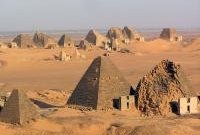
It is good to see Meroë on the list for possible inscription in 2010. One of the “Top 50 Missing” identified by users of this Web site, it is incontrovertably “World class” and needs to be present on any credible UNESCO list, even though “Egyptian civilisation” is already quite well represented. I visited it in Dec 2005 – just we 3 visitors across the whole evening, night and morning we spent there - so different from the crowded sites in Egypt! Meroë is primarily about pyramids (Photo - there are an amazing 200 or so of them) and atmosphere – which you must sense as you clamber up and down the sand dunes to enter the enclosures just like some Victorian explorer getting there for the first time – oh and look out for the tablets with Meroitic script too!
The T List documents rather strangely call it “The Island of Meroë”. I say strangely because it isn’t an “island” and is in fact located a distance away from the Nile, very much in the sandy desert. It appears that this phrase was used by Classical writers to describe the entire region from Atbara in the North to Khartoum in the south – at these 2 extremities, around 300kms apart, the main Nile is joined by the Atbara and Blue Nile rivers. These rivers on 3 sides led to use of the term “island” with some poetic license! The area was the heartland of the Meroitic civilisation around the 3rd …
Keep reading 0 comments
